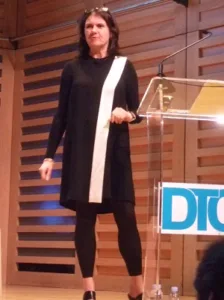Freeview is the UK’s free DTT platform. For several years Ilse Howing – MD of connected TV at Digital UK, which looks after Freeview – has wanted to talk about a connected proposition for the platform. At the 2015 event, she was finally able to.
Freeview Play is a connected – but still free – platform for TVs and STBs, offering broadcast, on-demand and catch-up content (Freeview Rebrands for Connected Future). The only cost will come in the initial product purchase. The platform was developed to help consumers navigate the complex world of smart TV. There are many, many platforms. A video showed consumers (after having Freeview Play described to them) that were enthusiastic – especially about the free aspect and the ability to collect content sources into a single location.
An investment into Freeview Play was announced last year, and an open specification is available now. Digital UK is asking for a “small” contribution from manufacturers and content providers using the platform. A “very large” number of manufacturers have expressed an interest in Freeview Play, and three – Panasonic, Humax and Vestel – have signed up (Panasonic is First TV Manufacturer for Freeview Play and Humax Will be First STB Partner for Freeview Play).
A new technical specification for Freeview Play was developed last autumn, through collaboration between Digital UK and the manufacturer partners. The platform will be launched this year.
We had a world-first look at Panasonic’s Freeview Play UI. This was designed by Panasonic – Digital UK provides the specification, but the design is up to the manufacturer.
Panasonic’s UI is largely the same as a normal EPG, but with the addition of a catch-up button and a back arrow, to browse linear content that has already been aired. Quick access to third-party platforms like the iPlayer and All 4 is at the top of the menu.
Freeview is now watched in 20 million homes, said Howling. The 100 millionth item of Freeview equipment was sold this month.
Howling was asked how confident she is that other manufacturers, as well as those already announced, will install Freeview Play. She said that the number of manufacturers who had expressed an interest is more than 40 or 50, but avoided the question of how many would actually install it.
Hewlett asked the Samsung representative in the audience, who had spoken before, what the company’s view was on Freeview Play – Samsung has its own connected TV platform, so is unlikely to want a competing system. Being put ‘on the spot’, the rep avoided the question quite neatly, saying, “We are interested in anything that will help us to sell more televisions”.
Asked about pricing, Howling said that the Humax box would cost either £200 or £300 ($315 or $470) – she could not remember exactly which. Hewlett noted that this is a high price for an STB, and Howling replied that the first Freeview STBs to be sold were also expensive – but they fell fast. She also did not feel that the platform was arriving too late – 60% of pay-TV consumers and 70% of existing Freeview customers had said that they would like such a system.
A final questioner asked about Freeview Play’s relation to the HbbTV 2.0 spec. HbbTV 2.0 has become the core standard to which manufacturers make TVs, said Howling. V1.5 has lower specifications and is used on many TVs today; Digital UK could have aimed its new platform at these TVs, but instead chose to go with v2.0 as a base for Freeview Play. This means that firmware upgrades for existing TVs to support Freeview Play will not be possible.

